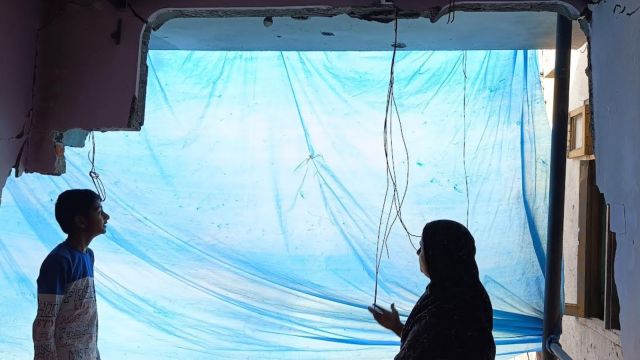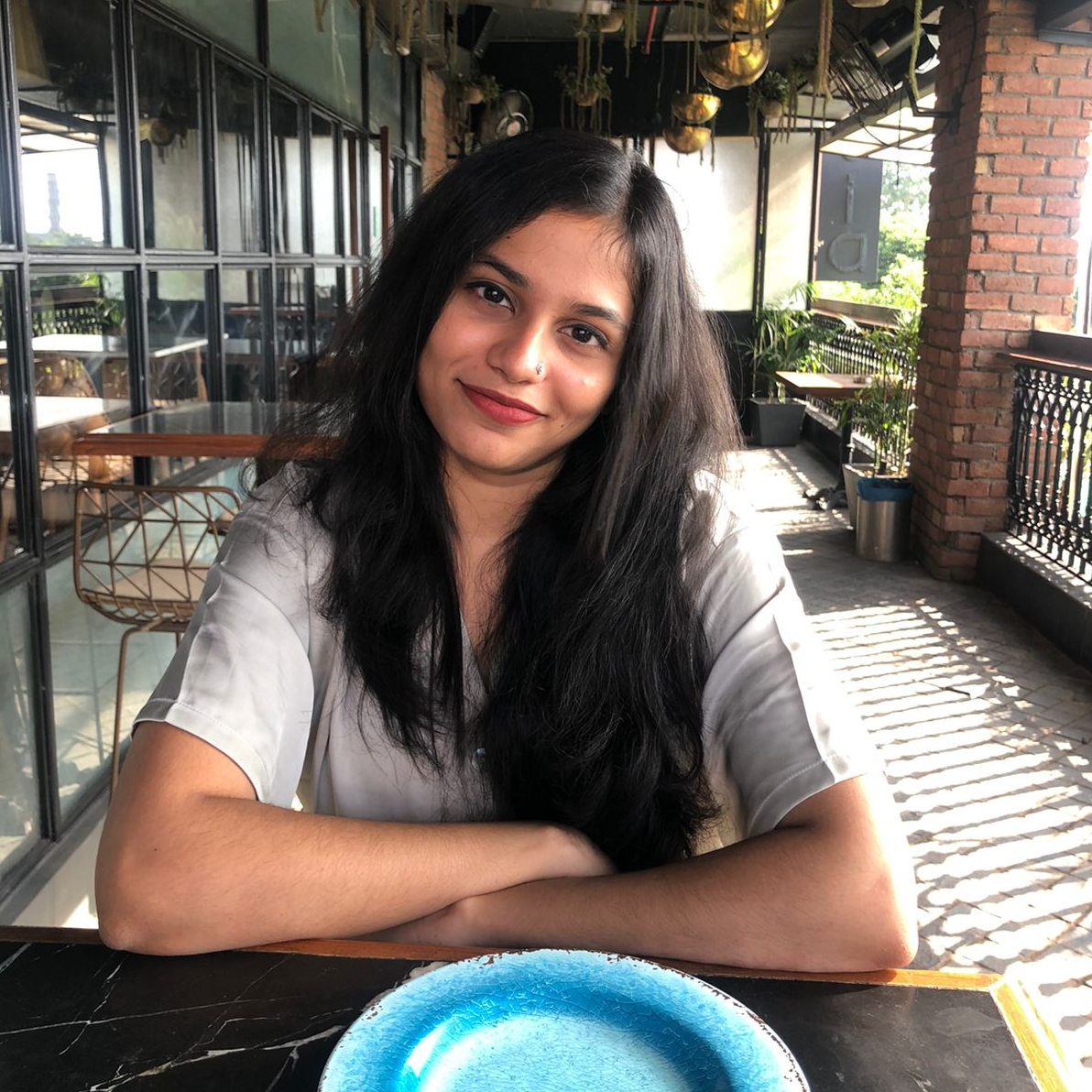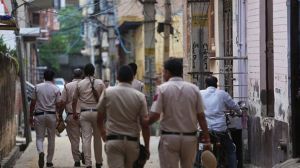Kamlesh Kumari points to a tree, around 500 metres from where she stands on the terrace of her house, next to a gaping hole left behind by a shell that landed on May 10, hours after the announcement of a pause on military action between India and Pakistan.
“The shells came from there, beyond that tree,” she says. “That’s the other side.”

From the time she came to Pallanwala, a village on the Line of Control (LoC), as a young bride 26 years ago, Kumari, 45, has spent several lazy afternoons listening to sounds from beyond the tree.
Story continues below this ad
“I often wonder how life is across the border; if, like us, they too have to empty out whenever there is tension, if they have bunkers like we do. When they have weddings, we hear it. I hear the azan from the mosque — sometimes, it’s a child who recites the prayers and at times, it is an old man,” she says.
 Kamlesh Kumari at her house on the Zero Line in Akhnoor’s Pallanwala. (Express Photo by Aiswarya Raj)
Kamlesh Kumari at her house on the Zero Line in Akhnoor’s Pallanwala. (Express Photo by Aiswarya Raj)
But when things go wrong, as it did last week, she looks across the border with suspicion.
“You see that structure,” she says, pointing to a nearby watchtower. “That must have drawn the enemy’s attention to our village.”
Kumari’s house, where she lives with her husband, three children and her father-in-law, is one of the few occupied ones in Pallanwala, a village that was left almost deserted in the years following the 1999 Kargil War.
Story continues below this ad
She recalls how her first day in Pallanwala as a new bride in 1999 was the scariest.
“There was firing all night. I am from Jourian village, 35 km away, and all this was new to me.”
The firing and shelling continued relentlessly until July and then, sporadically, every time Pakistan breached ceasefire agreements. Over time, the residents moved out of the village and the ones who stayed left for their relatives’ homes whenever the border got tense.
“Had I known I was marrying into all this, I would not have agreed,” says Kumari, asserting she won’t get her daughter married to any of the villages near the LoC.
Story continues below this ad
Over the last few days since Operation Sindoor was launched on May 7, access to the village of 50 households and 260 people has been largely restricted.
“Over the last few weeks, we have not been staying the nights here — we have dinner and leave for a relative’s house, 10 km away. So we were luckily not home when the gola (shell) landed on May 10,” she says.
That night, the shell had pierced through the roof of her bedroom, bringing down a portion of the ceiling with it and destroying the water tank.
“We had built the house only in 2014, after demolishing our older one,” she says.
Story continues below this ad
The family hasn’t cleared the debris yet, fearing it may not be over yet.
“People all over are clamouring for war. They don’t know how ugly it can be — to see your loved ones struck down, your house in ruins,” she says.
📍Rajouri (12 km from LoC)
On May 10, an hour after the shells landed on Rajouri town, Hussan Akhtar, 51, and her 11-year-old son had run out of their first-floor house.
“Our landlord’s nephew rushed inside to get us out. He was crying when he saw us, and asked us not to turn back and look at the rubble. When I did, I was horrified — the bed on which I was sleeping just a few minutes ago had vanished, it had blown up,” she says, her voice trembling.
Story continues below this ad
On May 10, Rajouri town saw heavy shelling that left three people dead — Additional District Development Commissioner Raj Kumar Thapa, and two migrants from Bihar, two-year-old Aisha Noor and her father Mohammad Shohib.
 Over 50 houses were damaged in villages in Uri tehsil. (Express Photo by Shuaib Masoodi)
Over 50 houses were damaged in villages in Uri tehsil. (Express Photo by Shuaib Masoodi)
At her house that now has a blue tarpaulin covering the massive hole left behind by the shelling, Hussan counts her blessings — the battered quarters of ADDC Thapa was only metres away.
“We are lucky to have survived,” she says.
That morning, Hussan, a single mother, had woken up around 5 am for her prayers. The sirens went off soon after, so she quickly moved into a smaller study, where her son, a Class 6 student, had dozed off after his lessons the previous night.
“I started praying and minutes later, there was a loud explosion. I finished my prayers and stayed close to my son. After some time, when it seemed quieter, I asked my son to bolt the windows. That’s when he said the windows had all been blown away. We sat there, praying, until someone came to help,” says Hussan, who teaches in a government school in a village in Rajouri.
Story continues below this ad
The family now stays in a smaller one-room house nearby, visiting their home to salvage their belongings. A carrom board lies in one of the rooms, its coins scattered. Hussan’s son Abu Zar Ghaffari clears the dust and the rubble, trying to find the coins. He spots a shrapnel instead and pockets it — “one more,” he says.
Hussan says, “Abu keeps saying we have lost everything. But I try to stay optimistic. At least my son is safe.”
📍Poonch (8 km from Chakkan da Bagh crossing at LoC)
Minutes before daybreak on May 7, Afreen Firdous, 19, was startled by the sound of a deafening crash outside their house near the Police Lines area of Poonch town.
Her father Mohammad Akram, 40, rushed to the door to lock it. The next minute, he was on the ground — a shrapnel had pierced his chest before exiting the body. Though partially shielded by her father, the splinters hit Firdous too — one each on her right arm, head and face.
Story continues below this ad
Minutes later, with her father still lying motionless, her mother Farida, 38, rushed Firdous to the district hospital, hardly a kilometre away.
 A house in Poonch town after being hit by shell. (Express Photo by Aiswarya Raj)
A house in Poonch town after being hit by shell. (Express Photo by Aiswarya Raj)
Akram, a labourer, is among the 13 people who died in Poonch, a town that was among the first border towns to come under attack from the Pakistani side last week.
With Akram no more and the town witnessing heavy shelling, the family — Farida and her six children — left Poonch, their home for the last 30 years, for their village in Poonch district’s Mandi tehsil.
Now back home, Farida says, “Firdous’s Class 12 results had been declared just a week ago and we were proud that she would go to college. I studied only till Class 4 and my husband till Class 10, so seeing our daughter in college was our biggest dream. Firdous was looking up courses in universities, but now with her father gone, she says her life is over. Even if we get some compensation from the government, we can at best run the household for three years, but can it bring back the life we had with him?”
Story continues below this ad
 A house in Poonch town after being hit by shell. (Express Photo by Aiswarya Raj)
A house in Poonch town after being hit by shell. (Express Photo by Aiswarya Raj)
Firdous sits nearby, her hand swathed in gauze.
On May 15, a week after the first shell dropped, the neighbourhood saw people emerging out of their homes to take stock of the losses and join in the mourning of their neighbours.
On one side of the lane are houses with holes pierced into their green, blue, and white walls, their doors blown off their hinges and glass panes shattered. On the other side is a crater, where the shell fell on May 7, sending shrapnel flying in all directions.
The topography of Poonch makes it especially vulnerable to artillery attacks from across the border. Pakistan has several dominating artillery positions near Ajote, Guntrian, Malti, Digwar, Mandi and Jhallas on the Indian side.
Early on May 7, when the shells fell, there were no sirens, blackouts or advisories. The town was anticipating a mock drill in the evening. Nothing was out of the ordinary.
“One shell fell near our house and one on the other side of the road. Everyone, including the police, were caught off guard. No one could help us,” says Farida.
Their neighbourhood was preparing for a wedding that day, with a makeshift kitchen readying food for the guests who were expected to turn up for the mehendi ceremony.
On the other side of the town, shells rained on structures near the district hospital — one struck near a gurdwara and another hit a madrasa. Qari Mohammad Iqbal, a 55-year-old teacher at the Jamia Zia Ul-Uloom madrasa, died when a splinter hit him.
A week after the shelling, the classrooms and the hostels at the 50-year-old madrasa, which has around 500 students from different parts of the state, stayed shut. A gaping hole marks the spot where the shell fell on a building under construction on the campus.
The steel railing, doors, curtains, and windows that stood from across the building sported deep gashes from the splinters.
Iqbal’s quarters was metres away from where the shell landed. The teacher was sitting on his bed when a splinter slashed through his red curtains and impaled him.
Maulana Sayeed Ahmed Habib, 51, the vice-principal of the institution, says, “On the morning of May 7, when the shelling started, I was rushing to send the children away with their parents. Around 8 am, we heard a crash and a cloud of dust rose from behind the madrasa. We rushed there and saw Qari trying to get out of the room. Three children were also injured. Around 9.15 am, Iqbal was declared dead. We sent his body to his home in Mandi,” Habib says.
Worse was to follow. Hours after Iqbal’s death, videos from a news channel did the rounds on social media, labelling him a Lashkar terrorist and claiming he had been killed in Pakistan-occupied Kashmir (PoK). The Poonch police later issued a clarification, warning media and social media handles not to resort to disinformation.
“The man worked all his life, stayed a gentleman, and after his death, he is labelled a terrorist. What can be a bigger tragedy,” says Habib.
📍Bandi village, Uri (15 km from LoC)
In a span of three minutes on the morning of May 11, Mohammad Anwar Sheikh’s house had turned into a junkyard of mangled tin sheets, shattered windows, shards of glass and charred carcasses of birds.
“I don’t want to sit here,” says Myra Jan, Sheikh’s five-year-old daughter, her Winnie the Pooh in a tight grasp. Around her, the brick walls are shattered, the furniture shredded, doors and windows thrown out of their frames and the rooftop pockmarked with splinters.
On May 11, Myra, a kindergarten student at the Boys’ Primary School at Lower Bandi, left her home with her brother and mother as the shells began to rain on Bandi village on the Baramulla-Uri highway. Sheikh, 45, moved the family to a room he had taken on rent around 2 km away, while he stayed back with his birds — some 80 pigeons and chicken. None survived the attack.
Now back home for the first time since the attack, Myra gets to work straight away, rummaging through the debris for her three teddy bears. She finds them covered with broken glass — one in the living room, the other two under the staircase.
 While the village is safe from the small-arms fire that rattle the LoC, it is often in the crosshairs when tensions soar and high-caliber weapons are used. (Express Photo by Shuaib Masoodi)
While the village is safe from the small-arms fire that rattle the LoC, it is often in the crosshairs when tensions soar and high-caliber weapons are used. (Express Photo by Shuaib Masoodi)
“I want to go back to Srinagar. I want to live there. Will I die?” she says, tugging at her father’s sleeve.
Bandi, one of the 48 villages in Uri tehsil of Baramulla district, is around 15 km from the Line of Control as the crow flies, but is in direct sight of the Pakistani Army posts in the Haji Pir sector.
Uri, which is connected to Muzaffarabad in PoK through the Aman Setu or Kaman bridge, has witnessed heavy shelling since May 7 — a woman was killed, 15 people were wounded and over 50 houses were damaged in villages in the tehsil.
While the village is safe from the small-arms fire that rattle the LoC, it is often in the crosshairs when tensions soar and high-caliber weapons are used. The last time the village came under Pakistani attack was during the Kargil War, Sheikh says.
On the morning of May 11, Sheikh, 45, says that over a dozen artillery shells fired from Pakistan landed on Bandi village with a deafening sound — three of those outside his house.
“The police had come the previous night and asked us to switch off the lights and move to safer places,” he says.
The Sheikhs had a space under the verandah that they used as a coop for their birds. That night, they moved the birds to the attic and turned the coop into a temporary bunker.
“As the shelling began, I went to my brother’s house that’s behind mine and both of us hid in the coop. It was unbearable there but what could we do? I watched my house getting hit,” Sheikh says.
As the shelling stopped, Sheikh and his brother rushed out of the village.
“I turned back to look at the house, but we had no time to go inside. We just ran for safety,” he says.
Now, five days later, the family sits around on the verandah of their house, recalling the horrors of that night and listening to Sheikh as he counts his losses — a house in ruins, 80 dead birds and with hardly any means to start afresh.
“I am a labourer and there is no work these days. The government should relocate us to some safer place,” he says.
Sheikh’s 15-year-old son Farhan, who had been listening intently until then, says, “I don’t want to live in constant fear… Every time something goes off — even if it is a firecracker — we have to rush and huddle under the staircase.”
Myra interjects: “Mujhe patakhe phodna pasand hai, magar yeh gola toh bahut khatarnak hai (I love firecrackers but these shells are very dangerous).”
📍Batapora village, Kupwara (7 km from LoC)
As Tasveer Ahmad Aawad’s eyes sweep over the debris that was once his house, he picks up a charred item lying on the floor.
“What will I do now?” he murmurs, sighing deeply as he inspects the remains of his electric chainsaw.
For Tasveer, 40, who cuts wood as a daily-wage labourer, the chainsaw was his lifeline. He is counting bigger losses: his two-storey house in Kashmir’s Batapora village was charred in a fire following an artillery strike by Pakistan on May 6.
The fire engulfed his house in Kupwara district’s Karnah tehsil when an artillery shell from Pakistan hit a taxi parked outside. The flames also consumed a few shops and some other houses.
Tasveer says that as the shelling intensified, he and his neighbours ran towards an underground community bunker in the neighbourhood.
 Back home for the first time since the attack, Sheikh’s daughter Myra Jan rummaged through the debris for her toys. (Express Photo by Shuaib Masoodi)
Back home for the first time since the attack, Sheikh’s daughter Myra Jan rummaged through the debris for her toys. (Express Photo by Shuaib Masoodi)
Located 78 km from Kupwara town, Karnah is a bowl-shaped tehsil surrounded by the LoC on three sides. A high mountain pass called Sadhna connects it to Kupwara in north Kashmir.
As the Pakistan Army stands strategically on higher positions, some of the 42 villages in Karnah — a few of them beyond the LoC border fence — are often in the line of fire. Tasveer’s Batapora village, less than 7 km from the LoC, is one such village.
Surrounded by agricultural fields on two sides, an Army artillery unit lies on one side of Batapora village.
Tasveer, who says he spent the night of May 6 in his brother’s bunker as the shells rained down on the village, says he is barely able to make ends meet for his family – wife, two daughters, aged 16 and 14 years, and a son, aged 11 years.
“We couldn’t save anything other than the clothes we were wearing,” his wife Nargis Begum rues.
Inside their burnt house lie their daughters’ charred school books, melted pots, a scorched washing machine and fragments of a gas cylinder that exploded in the fire.
Stating that the sound of explosions makes him feel “like my heart will explode,” Tasveer adds, “We are living on a live ammunition dump and could be reduced to ashes at any time. Whenever there is a loud sound, our hearts pound faster. We would like to move out of this place if the government can help.”
Aman Safeer, 10, a student of Class 3 at Army Goodwill School, disagrees with his uncle.
“I get scared, but where will we go? I don’t want to leave this place. My friends are here, so is my home,” he says.


 Kamlesh Kumari at her house on the Zero Line in Akhnoor’s Pallanwala. (Express Photo by Aiswarya Raj)
Kamlesh Kumari at her house on the Zero Line in Akhnoor’s Pallanwala. (Express Photo by Aiswarya Raj) Over 50 houses were damaged in villages in Uri tehsil. (Express Photo by Shuaib Masoodi)
Over 50 houses were damaged in villages in Uri tehsil. (Express Photo by Shuaib Masoodi) A house in Poonch town after being hit by shell. (Express Photo by Aiswarya Raj)
A house in Poonch town after being hit by shell. (Express Photo by Aiswarya Raj) A house in Poonch town after being hit by shell. (Express Photo by Aiswarya Raj)
A house in Poonch town after being hit by shell. (Express Photo by Aiswarya Raj) While the village is safe from the small-arms fire that rattle the LoC, it is often in the crosshairs when tensions soar and high-caliber weapons are used. (Express Photo by Shuaib Masoodi)
While the village is safe from the small-arms fire that rattle the LoC, it is often in the crosshairs when tensions soar and high-caliber weapons are used. (Express Photo by Shuaib Masoodi) Back home for the first time since the attack, Sheikh’s daughter Myra Jan rummaged through the debris for her toys. (Express Photo by Shuaib Masoodi)
Back home for the first time since the attack, Sheikh’s daughter Myra Jan rummaged through the debris for her toys. (Express Photo by Shuaib Masoodi)






























